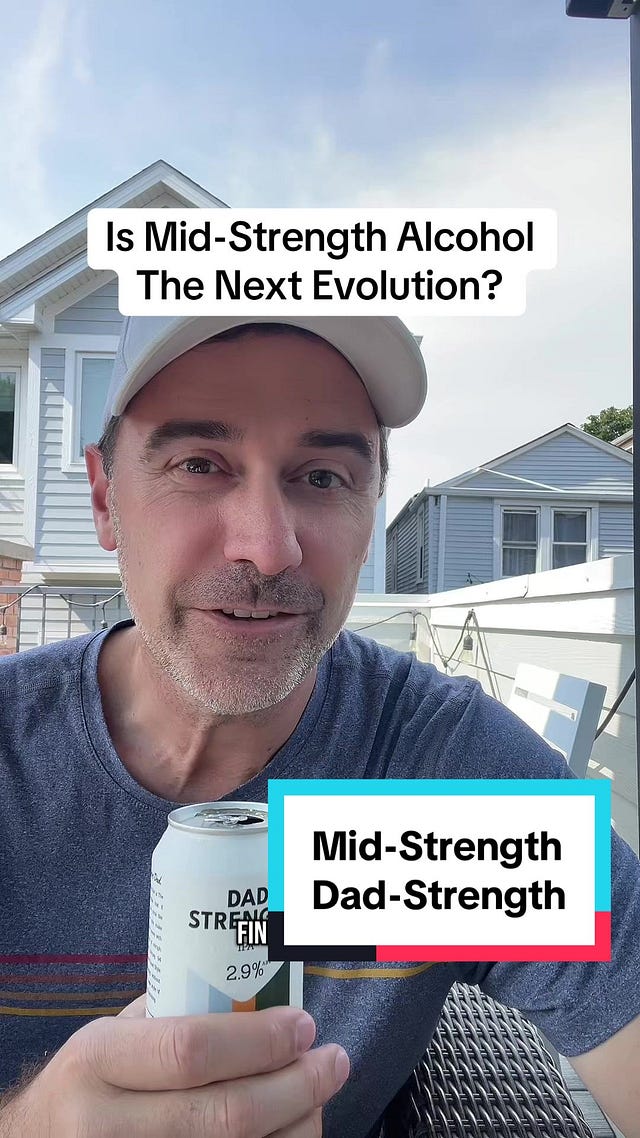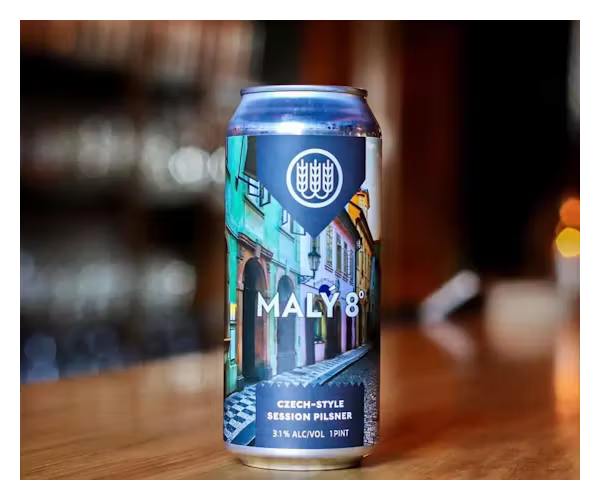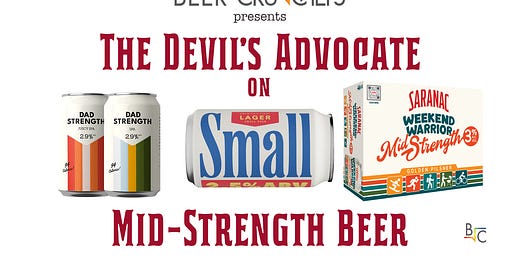Picture yourself walking into a bar or brewery taproom, you glance at the menu, and tucked between the pilsner and double IPA sits a small 2.7% beer. Curiosity piques, eyebrows rise, and somewhere in the room you can almost hear the scoff, “Why bother?” That reaction, consisting of equal parts confusion and knee-jerk skepticism, is exactly why mid-strength has earned a visit from your least favorite Beer Cruncher alter-ego…
In a country where “more” has long equaled “better,” lowering the octane feels almost un-American. Yet the same drinkers who once tracked IBUs and check-ins are now counting steps, macros, and mornings after. Enter mid-strength, the middle lane between full-throttle pints and the zero-proof choices. It is small, yes, but gaining traction because it may just fit the modern drinking puzzle better than either extreme.
So let’s challenge the knee-jerk critiques. Does lower alcohol really mean lower value? Is this just another marketing makeover in craft clothing? Wouldn’t it be simpler to sip fewer big beers instead? All fair questions, and ones that deserve tougher answers that go beyond the character count that TikTok provides me in the comments. Consider this your guided tour through those objections, with a healthy dose of devil’s advocacy. Because if mid-strength is going to matter, it has to run the gauntlet first and we’re here to see if it makes it to the other side.

 Tiktok failed to load.
Tiktok failed to load.Enable 3rd party cookies or use another browser
“If the ABV is half, then it should cost half as much”
By that logic, non-alcoholic beers should be free.
And just like non-alcoholic beers, mid-strength beer with their lower alcohol content can cost more to produce than their full-strength equivalent. The better tasting examples aren’t watered down, but instead use specific techniques and ingredients to take on the tall task of preserving flavor, body, and aroma while keeping the ABV in check.
This might mean longer brew times, more expensive specialty malts, or extra steps to fine-tune the final product. When the goal is to create a beer that drinks like a full-strength version without the same effects, it can take more skill, not less. And with mid-strength beer appealing to a more niche customer, that smaller scale naturally requires higher prices for the economics to work.

There’s also a value perception at play. Mid-strength recipes are designed for a particular type of drinker looking to moderate, stay sharp, or enjoy a few without going overboard. That customer is choosing experience over alcohol content and pricing needs to reflect the thought and care that went into making that possible. If mid-strength beers are priced too low, they risk being seen as less than the real thing. A slightly higher price signals that this isn’t a compromise. It’s a considered, high-quality option made for a modern drinking mindset.
Enjoying Beer Crunchers so far? Go full access and support the hard work that goes into these posts for the approximate cost of one draft beer per month. Your support is greatly appreciated.
“This is just marketing’s latest attempt to make ‘session’ happen”
I prefer to save my stones to throw at marketing for when they’re chasing a cheap, easy win. Let’s get one thing straight…there’s going to be nothing easy about making mid-strength happen. It will take a lot of conviction, investment, patience and a brand that can reach wide while the segment is still small. In short (or small), consumers need to learn that mid-strength beer exists before they will truly embrace it.
And are we sure Session IPAs failed? Or hear me out, did most breweries just back off the challenge that it takes to market them, leaving them middling in portfolios with in adequate investment dollars and no choice but to get discontinued as soon as a shiny new trend would come about that looked like less of a slog. I mean, look at Founders, who actually went all in on All Day IPA and stuck to their guns. They’re the 9th largest “craft” brewery per NIQ, with over half of their $137M in sales consisting of a Session IPA.
While mid-strength beers and session beers often live in the same ABV neighborhood, the rise of mid-strength in the U.S. reflects a broader cultural shift, not just a marketing tweak. Session beers traditionally come from the pub culture of the UK, where drinking several low-ABV pints over the course of an evening is the norm. In the U.S., they’ve long been seen as a niche style, often tied to pale ales or lagers that lean lighter but still carry craft credibility. Mid-strength beer today, on the other hand, is less about style and more about intention. They’re showing up across IPAs, hazies, pilsners, Mexican lagers, and even stouts, with a common goal: offer a full-flavor experience without the after-effects of higher alcohol.


More importantly, mid-strength speaks directly to modern drinking habits. People aren’t just looking for "crushable" anymore. They’re making more conscious choices around health, productivity, and moderation. It’s the same consumer who is exploring non-alc beer, low-dose THC drinks, or even zero-proof spirits. Mid-strength fits into that same mindset, offering balance rather than abstinence. So while it might overlap with the Session category in ABV, it’s not just a rebrand. It’s a response to a changing lifestyle where people want to enjoy great beer, but as Small Beer puts it, “you’ve got shit to do the next day.”
“I’d rather just have fewer, full-strength drinks”
This reaction tends to come from mid-strength’s critics, but misses the point because that’s not how most people engage with beer. Someone choosing a mid-strength beer isn’t just trying to reduce alcohol, they’re trying to stay in the moment without it getting away from them. They want the full glass, the full flavor, the social ease of having another without second-guessing their decision. Telling them to “just drink half” turns the entire experience into a mental chore, when the point is to make it effortless.
Moderation is hard. It’s a lot easier to incorporate a safety net with a lower-octane option than to have to focus on a modified pace that can take away from the gathering. Rather than preaching restraint, mid-strength beer bakes it in and if you’re the type who thinks that’s weak or unnecessary, then it’s just not for you is all. But it’s clearly striking a chord with a growing group of drinkers who are looking for more flexibility, that isn’t completely non-alcoholic, without having to leave the beer world behind.
It’s Early for Mid
Maybe mid-strength beers are a tough sell right now. They sit in a bit of a limbo by not providing enough value for the high-ABV loyalists, not abstinent enough for the zero-proof crowd. But limbos have a way of turning into sweet spots if the timing’s right.
Beer needs something in the way of new energy. No one’s saying mid-strength is the future of beer. But the segment is positive, compelling, and as a result, might become a part of it. For some, it’s a smarter way to stay social without sacrificing flavor. For others, it’s a confusing half-measure that solves a problem they don’t feel they have. And if you are playing Devil’s Advocate, you can probably see how both perspectives have a leg to stand on.
Still, there’s something refreshing, not just literally, about a beer that slips easily into your plans instead of rewriting them. Whether you see it as a thoughtful evolution or just another swing from Marketing Mitch, at least we’re talking about beer. And if nothing else, that’s worth raising a half-full glass to.
Drop your thoughts on Mid-Strength below and if you enjoyed today’s piece, please consider a premium subscription👇🙏









It is assumed that mid strength beers are lower in calories and carbs that the typical 5% beers, true? If so, it would be a real trick to achieve the full body/flavor promise for beer appreciators.
I wonder if the diet benefits today wouldn't be as good a draw to this style as "staying sharp"? Though - I guess the folks at Miller (Phillip Morris) in 1975 showed us that "diet beer" is an oximoron - so, I guess staying sharp is just more attractive to beer drinkers to "keep your A1C on track..."